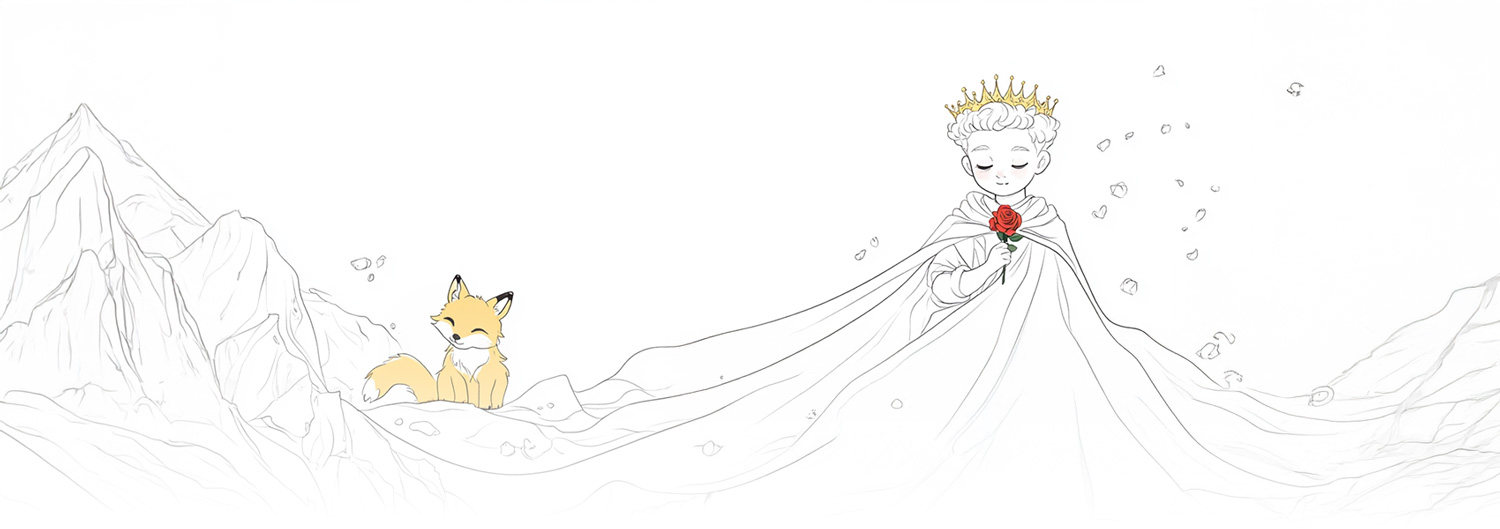
The Little Prince (1943), a novella by French aviator and writer Antoine de Saint-Exupéry, is a timeless fable that explores profound themes through the lens of a child’s innocence. Blending autobiography with allegory, the story critiques adult rationality while celebrating imagination, love, and existential purpose. Its layered narrative, poetic prose, and symbolic illustrations have cemented its status as a global classic, resonating across ages and cultures.
The Narrator’s Perspective
The story begins with the narrator, a pilot stranded in the Sahara Desert after a plane crash. His reflective tone reveals a disillusionment with adulthood, tracing back to his childhood when his drawing of a boa constrictor digesting an elephant was misinterpreted by adults as a hat. This early experience underscores the theme of adult myopia—their inability to see beyond literal appearances. The narrator’s isolation in the desert mirrors his emotional solitude, setting the stage for his transformative encounter with the Little Prince.
Encounter with the Little Prince
A golden-haired boy, the Little Prince, appears and requests a drawing of a sheep. Their interaction rekindles the narrator’s childlike wonder. The Prince’s origin—Asteroid B-612, a tiny planet with three volcanoes and a rose—hints at his symbolic role as a bridge between innocence and experience. His journey across the cosmos is both a physical and philosophical quest, seeking understanding of human nature and himself.
The Prince’s Home Asteroid
On Asteroid B-612, the Prince’s devotion to his rose—a vain, fragile flower—reveals themes of love and responsibility. The rose’s melodramatic nature strains their relationship, leading the Prince to doubt her affection. Her four thorns, meant to intimidate, instead highlight her vulnerability. The Prince’s departure, prompted by both hurt and curiosity, symbolizes the pain of growth and the search for meaning. The asteroid’s baobab saplings, which must be uprooted daily, serve as a metaphor for neglected problems that, if ignored, can destroy one’s world.
Visits to Other Asteroids
The Prince visits six asteroids, each inhabited by an allegorical adult figure:
Each encounter critiques adult absurdities—narcissism, escapism, and meaningless labor—contrasted with the Prince’s earnest curiosity.
Arrival on Earth
On Earth, the Prince’s journey deepens. A snake in the desert speaks in riddles (“I can send you back to the earth from whence you came”), foreshadowing the Prince’s ambiguous departure. In a rose garden, he confronts his rose’s ordinariness, feeling betrayed. This existential crisis—questioning his love’s uniqueness—leads him to the fox, the story’s philosophical core.
Lessons from the Fox
The fox teaches the Prince about “taming”—forming bonds through patience and care. “To me, you are still just a little boy like a hundred thousand other little boys…But if you tame me, we shall need each other.” This mutual “taming” creates responsibility (“You become responsible, forever, for what you have tamed”) and reveals that essence lies beyond the visible: “What is essential is invisible to the eye.” The Prince realizes his rose’s uniqueness stems from their shared time, transforming his sorrow into purpose.
The Well and Spiritual Realizations
In the desert, the narrator and Prince find a well, symbolizing spiritual sustenance. The Prince’s observation—“The men where you live grow five thousand roses in one garden and do not find what they are looking for”—critiques modern alienation from meaning. The well’s water, drawn with effort, becomes a metaphor for life’s sweetness earned through struggle and connection.
Departure and Transformation
The Prince’s return to his asteroid is facilitated by the snake’s bite, a symbolic shedding of his earthly form. His farewell—“You’ll have the stars as nobody else has them…all the stars will be your friends”—transforms the narrator’s grief into solace. The Prince’s fate remains ambiguous, balancing hope for his reunion with the rose and acceptance of mortality.
Key Themes and Symbols
Literary Style and Historical Context
Written during Saint-Exupéry’s WWII exile, the novella reflects his solitude and longing for a fractured world. Its simple, lyrical prose and watercolor illustrations (by the author) enhance its allegorical depth. Dedicated to his friend Léon Werth “when he was a little boy,” the book mourns lost innocence while affirming its enduring value.
Conclusion
The Little Prince is a meditation on love, loss, and seeing with the heart. Its critique of materialism and celebration of human connection resonate universally. The narrator’s final plea—“Look up at the stars. Think of that laughter”—invites readers to cherish relationships and the invisible essences that define our lives. In a world increasingly driven by efficiency and consumption, Saint-Exupéry’s tale remains a poignant reminder of what truly matters.